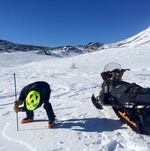
A snow-machine rider takes a snowpack reading as part of Community Snow Observations, a NASA-sponsored citizen science project.
Oregon State University/Flickr
There's a lot less snow in the western U.S. than there was a century ago. That's according to new research that found dramatic declines in snowpack as the seasons have gotten warmer.
Average snowpack in the West has dropped by up to 30 percent since 1915. To help you visualize that, that’s like permanently draining Nevada's Lake Mead, the largest man-made reservoir in the country.
Researchers said the decline in snowpack is connected to warming temperatures. That could have a big effect on wildlife, agriculture, cities and towns. They depend on snowmelt to supply water during the dry summer and fall months.
Philip Mote, the director of the Oregon Climate Change Research Institute at Oregon State University and the study’s lead author, said he was surprised at the rapid decline he saw since he began studying this in 2003.
“I wasn’t prepared for how much worse it had gotten in the intervening years,” Mote said.
The study found 90 percent of long-term snow monitoring sites in the West have less snow than 100 years ago. More than 30 of those sites saw significant decreases that could not have happened by chance, statistically, Mote said.
Researchers used a model that computed the amount of snow on the ground every day — using actual weather readings. They took the weather readings from 1,766 sites across the West. They ran the model over a time period of 100 years with real weather data.
They mostly keyed in on one date: April 1, historically a high-point for snowpack.
They found the biggest changes in snowpack in the spring in California, Oregon and Washington, and in places that had milder winters.
Then, they “re-ran the model without the warming trends that have been observed, and lo-and-behold, the large number of [declining snowpack] trends went away. It ended up being more balanced, 50-50,” Mote said.
They took that as another clear sign that snowpack is decreasing because of warmer temperatures, not a lack of precipitation.
One of place that’s seen the most snowpack decreases in the West is Eastern Oregon. Mote said the most recent low snow year in 2015 was a benchmark of where water problems have happened — and will continue to happen.
“The solution isn’t in infrastructure. New reservoirs could not be built fast enough to offset the loss of snow storage — and we don’t have a lot of capacity left for that kind of storage. It comes down to managing what we have in the best possible ways,” he said.
The study was published in NPJ Climate and Atmospheric Science, a Nature publication, and was funded by the National Oceanic and Atmospheric Administration’s Regional Integrated Sciences and Assessment (RISA) program, and the U.S. Environmental Protection Agency’s Office of Atmospheric Programs.
